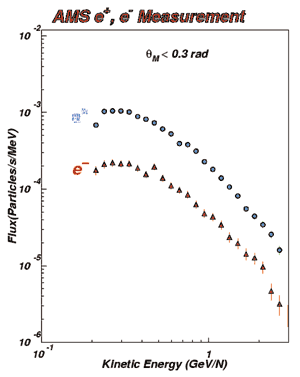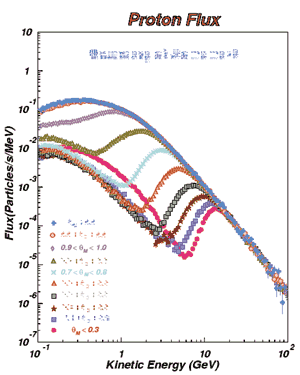

As reported briefly in the June issue, the Alpha Magnetic Spectrometer (AMS) presents several intriguing effects, which include unexpected distributions of cosmic-ray particles, from its 1998 trial Space Shuttle flight.
From 2 to 12 June 1998, AMS was the primary payload of NASA’s Space Shuttle Discovery in orbit 400 km above the Earth. This was a shakedown mission prior to deploying AMS on the International Space Station in a few years time.
AMS is a sophisticated magnetic detector of the type normally used in high-energy physics laboratories. During the 10 day voyage, AMS recorded the tracks of millions of cosmic-ray particles. It was the first time that such a sophisticated physics detector had been deployed in space and the first time so much information on cosmic particles had been recorded. The first results from this mission have been eagerly awaited.
The advertised goal of AMS was to search for signs of cosmic antimatter. In a universe created from a Big Bang that must have generated matter and antimatter in equal initial amounts, there should be signs of this primordial antimatter, with antinuclei built of antiprotons and antineutrons. However, our universe appears to be built up entirely of matter and no experiment has ever detected any primordial antimatter. AMS set out to look for antinuclei above the screen of the atmosphere, but a sample of almost 3 million cosmic helium nuclei arriving from outer space did not reveal one helium antinucleus. AMS sees no primordial antimatter, but 3 million nuclei is not many and the search continues. However, AMS did see several other unexpected effects, which show that the behaviour of cosmic rays is much more complicated than had been thought.
In orbit, AMS was able to intercept cosmic rays arriving at different latitudes as the Earth turned. Cosmic-ray protons have a range of energies and the Earth’s magnetic field should repel less energetic particles. This terrestrial magnetic repulsion becomes weaker at higher latitudes, and more particles of low energy should be seen nearer the poles, with a magnetic cut-off at each latitude. However, AMS finds that, below a certain proton energy for each latitude, there is no magnetic cut-off and the distribution increases strongly instead (figure 2).
When the Space Shuttle flips over, AMS can also collect cosmic particles moving upwards, away from the Earth. Few high-energy, upwards-moving protons are seen, but the spectrum fills up rapidly for lower-energy particles. In a band extending over 4000 km at the Space Shuttle orbit altitude of 400 km, below about 6 GeV AMS saw as many protons moving upwards as downwards. It is as though these particles are confined in a magnetic toroid around the equator.
A similar effect is found with electrons, but here it is interesting to compare the levels of electrons and their antiparticles positrons. If cosmic-ray electrons and positrons are created in pairs by high-energy gamma rays, there should be as many electrons as there are positrons. However, in the equatorial region AMS sees about four times as many low-energy positrons as it does electrons.
AMS also looked at the distribution of helium nuclei. In a final conundrum, around the equator and at low energies, AMS only sees the helium-3 isotope. Helium-3 is very rare on Earth but was one of the protonuclei formed during the one minute, or so, of the universe’s primordial nucleosynthesis.
AMS is a major international collaboration covering Europe, the US, China and Taiwan and is led by Sam Ting of MIT longtime spokesman of the L3 experiment at CERN’s LEP electronpositron collider.





